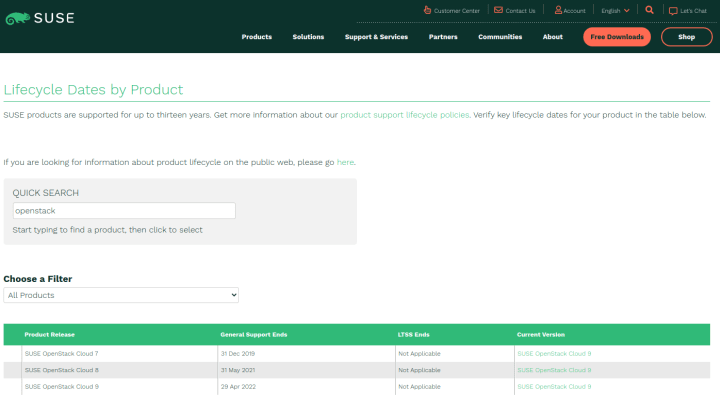Time passes by! A year has passed since SUSE announced its decision to discontinue SUSE OpenStack Cloud, and many enterprises are already affected. This is because SUSE OpenStack Cloud 8 reaches the end of life (EOL) in late May 2021.
There are 6 months left to solve this problem. So it is time to think about a solution. While there are many options available, ensuring business continuity, non-stop service availability and budget control is always a priority. Therefore, continuing to use OpenStack makes the most sense in the majority of cases.
Fortunately, SUSE is not the only vendor to offer enterprise-class services for OpenStack. There are also tools that enable a smooth migration from SUSE OpenStack Cloud to other OpenStack platforms. So don’t panic and continue reading!
RIP SUSE OpenStack Cloud
SUSE announced that they are dropping support for SUSE OpenStack Cloud on the 9th of October 2019. This decision came as a surprise to many as it came just a few months after a successful release of SUSE OpenStack Cloud 9. For many years, SUSE has been a solid contributor to the OpenStack project and a recognised vendor.
In the official announcement, SUSE stated, “SUSE is focusing on and increasing our strategic investments in the application delivery market and its opportunities in order to align with technology trends in the industry and, most important, with our customers’ needs. So SUSE will be working more on its Kubernetes-based application delivery offerings, SUSE Cloud Application Platform and SUSE CaaS Platform.”. As a result, SUSE OpenStack Cloud 8 and SUSE OpenStack Cloud 9 are now expected to reach EOL on the 31th of May 2021 and 29th of April 2022 respectively.
Apps need infrastructure
While there is a lot of truth in what SUSE stated about applications in their announcement, OpenStack remains an essential technology to many organisations. This is because applications still need an infrastructure to run on. Although Kubernetes and other Container-as-a-Service (CaaS) platforms provide infrastructure management capabilities, they are simply not designed for this purpose. As a result, implementing production-grade features on those platforms, such as multi-tenancy for example, is challenging.
Moreover, CaaS platforms enforce a cloud-native approach. This means that all services have to be re-designed and re-implemented based on a microservices architecture. While this is a possible option for start-ups and mid-size companies, it may be out of the question for large enterprises who run hundreds of applications in the cloud. Such a change usually requires a long-term plan, a significant budget and an alignment with the company strategy. And here, don’t forget, the clock is ticking.
So if your entire organisation is already running on SUSE OpenStack Cloud, the safest solution is to migrate to some other enterprise OpenStack platform before the current one reaches EOL. But before you pick a new vendor and make an investment, there are several important aspects to consider.
Move to Charmed OpenStack
Although I am going to use Canonical’s Charmed OpenStack as an example here, the same rules apply when considering other OpenStack platforms.
Ensure business continuity
No two OpenStack platforms are the same. Although all of them are based on the same open source code, the availability of certain features and services may vary across different vendors. Therefore, it is important to do your research and make sure that the new OpenStack platform of choice provides the same capabilities as SUSE OpenStack Cloud does. This helps to eliminate any surprises post migration and ensures the continuity of your business.
The following table provides a brief overview of SUSE OpenStack Cloud and Canonical’s Charmed OpenStack:
| Canonical’s Charmed OpenStack? | SUSE OpenStack Cloud | |
| Host OS | Ubuntu | SLES |
| Guest OS | Linux (including SLES), Windows | Linux (including SLES), Windows |
| Customisability | Fully customisable | Partially customisable |
| OpenStack upgrades | Fully automated | Very complex, manual procedure |
| Full-stack enterprise support | Yes: Host OS, Guest OS, OpenStack, Storage, K8s | No: separate subscriptions required per product |
| Managed services | Available at $5,775 per host per year | Not available |
Live-migrate services
When migrating to a new cloud platform, it is important to ensure the availability of services. Production environments usually run with aggressive service level agreements (SLAs) and an unexpected service downtime may result in significant penalties. In response to this challenge, Canonical cooperates with leading Migration-as-a-Service software vendors to ensure non-stop availability of services when migrating from SUSE OpenStack Cloud to Canonical’s Charmed OpenStack.
Integrate K8s
While Kubernetes is not designed to manage the underlying infrastructure, it is a platform of choice for containers coordination. Once you are ready to go cloud-native, it is important to be able to extend the underlying OpenStack platform with CaaS capabilities. Canonical’s Charmed OpenStack can be easily integrated with Charmed Kubernetes running on top of it. Following this approach enables users to run both traditional workloads and containers on the same infrastructure which results in cost savings as described below.
Keep budget under control
Last but not least, always watch your budget. Organisations frequently fall into traps with hidden license costs and non-transparent subscriptions. Canonical provides OpenStack and Kubernetes design & delivery services at a fixed price and fully transparent pricing model for both enterprise support and fully managed services. Canonical’s Ubuntu Advantage for Infrastructure (UA-) subscription provides full-stack support for both OpenStack and Kubernetes and is charged per-host as well as fully managed services. This enables predictable budgeting and helps to keep costs under control.
Learn more
Canonical stands ready to help existing SUSE OpenStack Cloud customers to migrate their services to Charmed OpenStack.
Learn more about Canonical’s Charmed OpenStack and Charmed Kubernetes.
Contact us for any questions you may have.
On January 27, 2021, join our webinar to discuss the similarities and differences between SUSE OpenStack Cloud and Canonical’s Charmed OpenStack and cover the migration process in detail. So do not hesitate and register today.
Additional resources:
- Whitepaper – “Comparing Red Hat OpenStack Platform and Canonical’s Charmed OpenStack”
- Webinar – “Hosted private cloud infrastructure: a cost analysis”
- Charmed OpenStack datasheet





